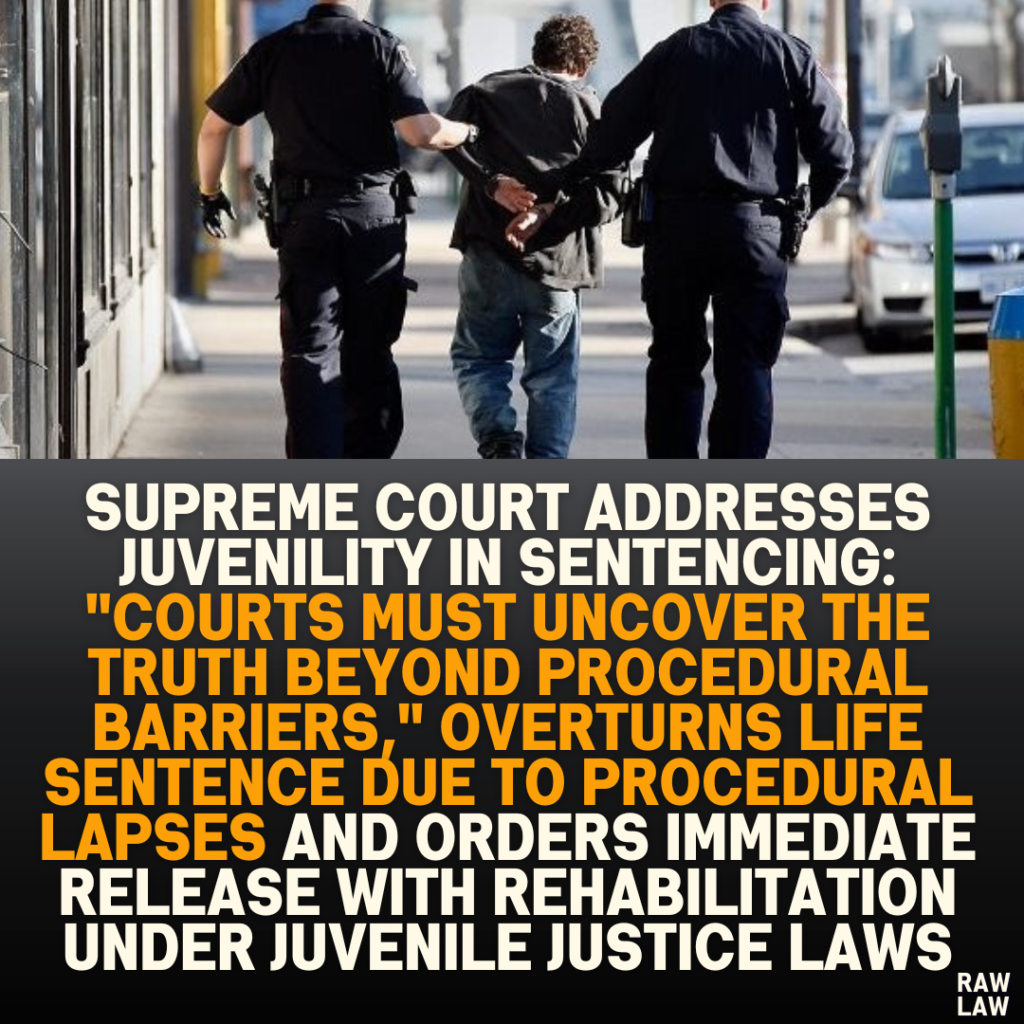Court’s Decision
The Supreme Court overturned the life imprisonment sentence imposed on the appellant, stating it exceeded the upper limit prescribed under juvenile laws. While upholding the conviction, the Court emphasized that the justice system must align with the truth and rectify procedural lapses. The appellant was ordered to be released immediately if not required in any other case. Further, the Uttarakhand State Legal Services Authority was directed to facilitate the appellant’s reintegration into society by identifying and applying welfare schemes for his benefit.
Facts
- Offense and Initial Trial:
The appellant was charged with culpable homicide amounting to murder, which occurred in 1994. During the trial, he claimed to be a juvenile at the time of the offense. His recorded statement under Section 313 of the CrPC listed his age as 20 years in 2001, implying he was 14 years old at the time of the incident. - Procedural Failures:
Despite presenting supporting evidence, such as school certificates and medical ossification tests, the courts repeatedly dismissed his claim. Instead, they relied on irrelevant evidence, like his ability to open a bank account, to reject his plea. - Subsequent Legal Actions:
After the conviction, the appellant continued to assert his juvenility at various stages, including appeals, review petitions, a writ petition, and even a curative petition. The death sentence was eventually commuted to life imprisonment, but the courts failed to adequately address his juvenility claims.
Issues
- Was the appellant a juvenile at the time of the offense?
- Did the courts comply with the procedural mandates under the Juvenile Justice Acts of 1986, 2000, and 2015?
- Can the plea of juvenility be raised and adjudicated after final case disposal?
Petitioner’s Arguments
- The appellant argued that his school certificate and ossification test conclusively established that he was 14 years old at the time of the offense.
- He cited Section 9(2) of the Juvenile Justice Act, 2015, which allows claims of juvenility to be raised “at any stage,” even after final disposal.
- The appellant contended that his prolonged incarceration violated his fundamental rights, particularly the rights guaranteed under Articles 21 and 14 of the Constitution.
Respondent’s Arguments
- The respondents argued that the matter had already attained finality, as the appellant’s juvenility claim was adjudicated during earlier proceedings.
- They contended that reopening the case would undermine judicial consistency and set a problematic precedent.
- The ossification test was dismissed as insufficient proof of juvenility, with the respondents emphasizing procedural correctness in earlier decisions.
Analysis of the Law
- Juvenile Justice and Constitutional Principles:
The Court highlighted the constitutional mandate under Articles 15(3), 21, and 39, which emphasize the state’s obligation to protect children. It noted that the Juvenile Justice Acts of 1986, 2000, and 2015 prioritize rehabilitation and reformation over punitive measures. - Retrospective Application of Juvenile Laws:
The Court affirmed that juvenile laws are beneficial legislation with retrospective applicability, meaning they apply to all pending cases, regardless of when the offense occurred. - Procedural Safeguards:
The Court criticized earlier proceedings for disregarding procedural mandates like age determination under Rule 12 of the Juvenile Justice (Care and Protection of Children) Rules, 2007. It held that reliance on irrelevant factors, such as bank accounts, was unjustified.
Precedent Analysis
The Court relied on the following cases:
- Hari Ram v. State of Rajasthan (2009): Established that juvenility claims can be raised even after final case disposal.
- A.R. Antulay v. R.S. Nayak (1988): Asserted that procedural errors by courts should not prejudice a party.
- Kehar Singh v. Union of India (1989): Highlighted the judiciary’s role in addressing injustices arising from earlier decisions.
Court’s Reasoning
- The Court observed that the appellant’s juvenility was a substantive right, not contingent on procedural lapses.
- It noted that the appellant’s age was clearly established by multiple documents, including school certificates verified by the state.
- The judiciary’s reliance on irrelevant factors, such as the appellant’s ability to open a bank account, demonstrated a fundamental misunderstanding of the legal framework governing juvenility.
- The Court held that procedural safeguards under juvenile laws must be prioritized to protect the rights of individuals in conflict with the law, particularly when dealing with minors.
Conclusion
The Court allowed the appeal and ordered the appellant’s immediate release. It clarified that the decision did not interfere with the Presidential Order but instead upheld the mandatory provisions of juvenile justice laws. The Court also directed the Uttarakhand State Legal Services Authority to facilitate the appellant’s rehabilitation, focusing on livelihood, shelter, and sustenance.
Implications
- The judgment reinforces the principle that juvenility claims are substantive rights that can be raised at any stage of legal proceedings.
- It establishes that procedural lapses cannot override the protective framework of juvenile justice laws.
- The ruling emphasizes the judiciary’s duty to actively seek truth and justice, ensuring constitutional rights are upheld.
- The Court’s directions for rehabilitation underline the importance of reintegrating reformed individuals into society.
This judgment is a landmark in ensuring the protection of juveniles’ rights and sets a precedent for judicial accountability in cases of procedural errors.




Pingback: Bombay High Court Orders Return of Sangli Land to Sansthan: Upholds Ownership Rights Under Shri Ganpati Panchayat Sansthan Act, 1940, Directs Government to Complete Action in Three Months or Initiate Acquisition - Raw Law